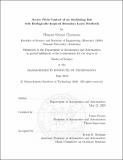| dc.contributor.advisor | Jaime Peraire. | en_US |
| dc.contributor.author | Chaurasia, Hemant Kumar | en_US |
| dc.contributor.other | Massachusetts Institute of Technology. Dept. of Aeronautics and Astronautics. | en_US |
| dc.date.accessioned | 2010-10-29T13:49:33Z | |
| dc.date.available | 2010-10-29T13:49:33Z | |
| dc.date.copyright | 2010 | en_US |
| dc.date.issued | 2010 | en_US |
| dc.identifier.uri | http://hdl.handle.net/1721.1/59554 | |
| dc.description | Thesis (S.M.)--Massachusetts Institute of Technology, Dept. of Aeronautics and Astronautics, 2010. | en_US |
| dc.description | This electronic version was submitted by the student author. The certified thesis is available in the Institute Archives and Special Collections. | en_US |
| dc.description | Cataloged from student submitted PDF version of thesis. | en_US |
| dc.description | Includes bibliographical references (p. 75-76). | en_US |
| dc.description.abstract | We present a high-fidelity numerical study of a two-dimensional °apping airfoil, ad- dressing the hypothesis that boundary layer feedback control can enable improved performance in flapping light. To this end, we model a novel biologically-inspired feedback controller which adjusts wing motion in response to the flow-induced bending load experienced by sensory hairs mounted on the wing. Such hairs have been observed on bats, and biological studies suggest that an associated feedback controller may play an important role in enabling bats' well-known mastery of light. The coupled °uid and structural equations of our model are solved numerically by a Discontinuous Galerkin finite element method, combined with an Arbitrary Lagrangian-Eulerian (ALE) formulation to account for airfoil motion. Feedback control is deed by a simple proportional-derivative (PD) control law relating hair sensor feedback to an applied torque at the pivot point of the wing. We also include a torsional spring at the pivot point to model passive aeroelasticity, following prior work by Israeli [5]. Our results show that hair sensors are well-suited for detecting flow separation, and sensors placed near the leading edge enable better light performance than sensors placed near the trailing edge. We compute a "performance envelope" for a purely passive flapping airfoil, and demonstrate that our active feedback controller enables improvements of up to 5% in propulsive efficiency. We also present gust alleviation experiments, where we find that an optimal PD controller reduces lift deviation by 33% compared to a spring-only airfoil. Mechanisms for these performance improvements are discussed. Our findings suggest that boundary layer feedback control may plausibly contribute to the outstanding °ight abilities of bats, and may also provide valuable clues for designing robust and maneuverable Micro Air Vehicles (MAVs). | en_US |
| dc.description.statementofresponsibility | by Hemant Kumar Chaurasia. | en_US |
| dc.format.extent | 76 p. | en_US |
| dc.language.iso | eng | en_US |
| dc.publisher | Massachusetts Institute of Technology | en_US |
| dc.rights | M.I.T. theses are protected by
copyright. They may be viewed from this source for any purpose, but
reproduction or distribution in any format is prohibited without written
permission. See provided URL for inquiries about permission. | en_US |
| dc.rights.uri | http://dspace.mit.edu/handle/1721.1/7582 | en_US |
| dc.subject | Aeronautics and Astronautics. | en_US |
| dc.title | Active pitch control of an oscillating foil with biologically-inspired boundary layer feedback | en_US |
| dc.type | Thesis | en_US |
| dc.description.degree | S.M. | en_US |
| dc.contributor.department | Massachusetts Institute of Technology. Department of Aeronautics and Astronautics | |
| dc.identifier.oclc | 668108895 | en_US |
